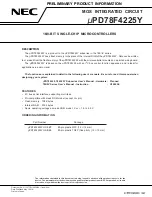
WIENER, Plein & Baus GmbH
21
www.wiener-d.com
The structure of data retrieved in conjunction with direct requests for data addressed to the
Register Block and to the CAMAC Stacks is simple, such that the buffer consists only of the
requested data.
The data buffers read during the data acquisition process have a structure depending on the
mode of buffering, i.e., whether event data are allowed to span two buffers (bit 3 of BoffOpt
set). Additionally, there are special rules for treating long events. These are discussed at the
end of this section.
For the Integer Event Mode, the data buffer has the following structure:
1. Header word
Bit 15 set indicates a watchdog buffer, bit 14 set indicates a
scaler buffer. Bits 0 – 9 represent the number of events in the
buffer.
2. Optional 2
nd
Header Word Bits 0-11 represent the number of words in the buffer.
3. Event Length
Event length including terminator words.
4-N1. Event Data
N2. Event Terminator
hexadecimal FFFF
N3. Optional 2
nd
Terminator
hexadecimal FFFF
.
. Subsequent Events
.
N5. Buffer Terminator
hex FFFF
The unpacking of the events must be done in accordance with the CAMAC Stack that is
involved in generating the buffer.
In the Split-Event mode, when events span two or more buffers, no buffer terminator is
written.
For the direct access of the CAMAC NAFGEN (Interactive CAMAC operations), no header
words are written and the In Packet contains only one event.
CC-USB has dedicated 2kWords-long event FIFO to assemble events. To handle longer
events, CC-USB splits the long event into parts, each of which appears as a separate event in
the output buffer. The partial events are distinguishable by bit 12 of the Event Length word
set, except for the last part. Also, only the last “installment” is terminated by the Event
Terminator word (s).
CC-USB has a provision to automatically change the output buffer packing mode to Split-
Event mode, whenever the Event Length exceeds the length of the Integer-Event buffer. The
fact of such a change is indicated by setting of bit 13 in the buffer header word.











































